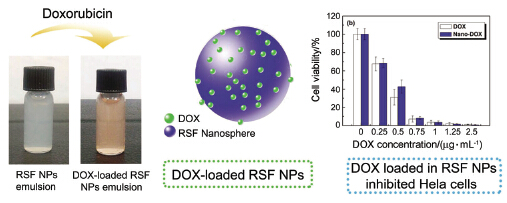| [1] Williams, D. F. Biomaterials 2008, 29, 2941.
[2] Naahidi, S.; Jafari, M.; Edalat, F.; Raymond, K.; Khademhosseini, A.; Chen, P. J. Controlled Release 2013, 166, 182.
[3] Elzoghby, A. O.; Samy, W. M.; Elgindy, N. A. J. Controlled Release 2012, 161, 38.
[4] Wang, Y. Z.; Kim, H. J.; Vunjak-Novakovic, G.; Kaplan, D. L. Biomaterials 2006, 27, 6064.
[5] Jiang, X. R.; Guan, J.; Chen, X.; Shao, Z. Z. Acta Chim. Sinica 2010, 68, 1909. (江霞蓉, 管娟, 陈新, 邵正中, 化学学报, 2010, 68, 1909.)
[6] Ma, X. Y.; Shi, L. J.; Zhou, J.; Zhu, J.; Zhong, J.; Wei, R. L. Chin. J. Org. Chem. 2013, 33, 1080. (马晓晔, 施丽君, 周涓, 朱君, 钟建, 魏锐利, 有机化学, 2013, 33, 1080.)
[7] Wei, Q. N.; Ma, L.; Huang, A. M.; Yang, H.; Gong, Z. P.; Qiang, P. P.; Zhang, L. Acta Chim. Sinica 2012, 70, 714. (韦俏娜, 马林, 黄爱民, 杨华, 龚珠萍, 强盼盼, 张丽, 化学学报, 2012, 70, 714.)
[8] Cao, Z. B.; Chen, X.; Yao, J. R.; Huang, L.; Shao, Z. Z. Soft Matter 2007, 3, 910.
[9] Moghimi, S. M.; Hunter, A. C.; Murray, J. C. Pharm. Rev. 2001, 53, 283.
[10] Swartz, M. A. Adv. Drug Delivery Rev. 2001, 50, 3.
[11] Oussoren, C.; Storm, G. Adv. Drug Delivery Rev. 2001, 50, 143.
[12] Liu, J.; Wong, H. L.; Moselhy, J.; Bowen, B.; Wu, X. Y.; Johnston, M. R. Lung Cancer 2006, 51, 377.
[13] Nishioka, Y.; Yoshino, H. Adv. Drug Delivery Rev. 2001, 47, 55.
[14] Liu, J.; Meisner, D.; Kwong, E.; Wu, X. Y.; Johnston, M. R. Biomaterials 2007, 28, 3236.
[15] Lee, S.; Baek, M.; Kim, H.-Y.; Ha, J.-H.; Jeoung, D.-I. Biotechnol. Lett. 2002, 24, 1147.
[16] He, H.; Wang, Y.; Wen, H.; Jia, X. RSC Adv. 2014, 4, 3643.
[17] Carvalho, F. S.; Burgeiro, A.; Garcia, R.; Moreno, A. J.; Carvalho, R. A.; Oliveira, P. J. Med. Res. Rev. 2014, 34, 106.
[18] Basuki, J. S.; Duong, H. T.; Macmillan, A.; Erlich, R. B.; Esser, L.; Akerfeldt, M. C.; Whan, R. M.; Kavallaris, M.; Boyer, C.; Davis, T. P. ACS Nano 2013, 7, 10175.
[19] Guo, Q. Q.; Wang, H. Y.; Zhao, Y. X.; Wang, H. X.; Zeng, F.; Hua, H. Y.; Xu, Q.; Huang, Y. Z. Polym. Chem. 2013, 4, 4584.
[20] Sanyakamdhorn, S.; Agudelo, D.; Tajmir-Riahi, H.-A. Biomacromolecules 2013, 14, 557.
[21] Liu, Z.; Sun, X. M.; Nakayama-Ratchford, N.; Dai, H. J. ACS Nano 2007, 1, 50.
[22] Yu, S. Y.; Yang, W. H.; Chen, S.; Chen, M. J.; Liu, Y. Z.; Shao, Z. Z.; Chen, X. RSC Adv. 2014, 4, 18171.
[23] Chen, M. J.; Shao, Z. Z.; Chen, X. J. Biomed. Mater. Res. A 2012, 100, 203.
[24] Chan, J. M.; Zhang, L. F.; Yuet, K. P.; Liao, G.; Rhee, J.-W.; Langer, R.; Farokhzad, O. C. Biomaterials 2009, 30, 1627.
[25] Cheng, J. J.; Teply, B. A.; Sherifi, I.; Sung, J.; Luther, G.; Gu, F. X.; Levy-Nissenbaum, E.; Radovic-Moreno, A. F.; Langer, R.; Farokhzad, O. C. Biomaterials 2007, 28, 869.
[26] Allen, C.; Dos Santos, N.; Gallagher, R.; Chiu, G.; Shu, Y.; Li, W.; Johnstone, S.; Janoff, A.; Mayer, L.; Webb, M. Biosci. Rep. 2002, 22, 225.
[27] Greenwald, R. B.; Choe, Y. H.; McGuire, J.; Conover, C. D. Adv. Drug Delivery Rev. 2003, 55, 217.
[28] Ma, G. L.; Zhao, S. X.; Jin, X.; Chen, M. M.; Zhang, Z. P.; Song, C. X. Chem. J. Chin. Univ. 2012, 33, 1854 (马桂蕾, 赵顺新, 金旭, 陈旼旼, 张政朴, 宋存先, 高等学校化学学报, 2012, 33, 1854.)
[29] Waku, T.; Matsusaki, M.; Kaneko, T.; Akashi, M. Macromolecules 2007, 40, 6385.
[30] Watson, P.; Jones, A. T.; Stephens, D. J. Adv. Drug Delivery Rev. 2005, 57, 43. |
